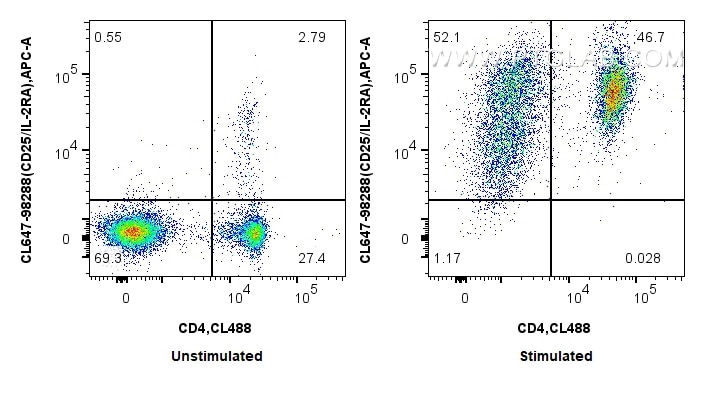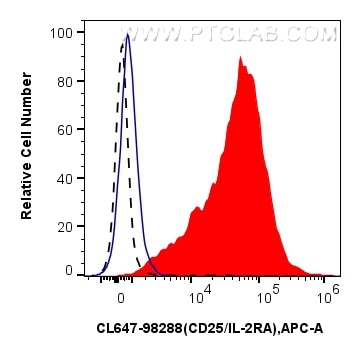Tested Applications
| Positive FC detected in | Anti-CD3/CD28 treated mouse splenocytes |
Recommended dilution
| Application | Dilution |
|---|---|
| Flow Cytometry (FC) | FC : 0.25 ug per 10^6 cells in a 100 µl suspension |
| This reagent has been tested for flow cytometric analysis. It is recommended that this reagent should be titrated in each testing system to obtain optimal results. | |
| Sample-dependent, Check data in validation data gallery. | |
Product Information
CL647-98288 targets CD25/IL-2RA in FC applications and shows reactivity with mouse samples.
| Tested Reactivity | mouse |
| Host / Isotype | Rabbit / IgG |
| Class | Recombinant |
| Type | Antibody |
| Immunogen | CD25/IL-2RA fusion protein Eg3087 Predict reactive species |
| Full Name | interleukin 2 receptor, alpha chain |
| Calculated Molecular Weight | 31 kDa |
| GenBank Accession Number | NM_008367.3 |
| Gene Symbol | CD25 |
| Gene ID (NCBI) | 16184 |
| Conjugate | CoraLite® Plus 647 Fluorescent Dye |
| Excitation/Emission Maxima Wavelengths | 654 nm / 674 nm |
| Form | Liquid |
| Purification Method | Protein A purification |
| UNIPROT ID | P01590 |
| Storage Buffer | PBS with 0.09% sodium azide, pH 7.3. |
| Storage Conditions | Store at 2-8°C. Avoid exposure to light. Stable for one year after shipment. |
Background Information
Proliferation of T lymphocytes is triggered by the interaction of IL-2 with its specific receptor following T lymphocyte activation. The receptor for IL-2 has three forms, generated by different combinations of three different proteins, the alpha chain (IL-2R alpha), the beta chain (IL-2R beta), and the gamma chain (IL-2R gamma) (PMID: 8476561). IL-2R alpha (also known as CD25) is a type I transmembrane protein present on activated T cells, activated B cells, some thymocytes, myeloid precursors, and oligodendrocytes. CD25 is also found on natural CD4+Foxp3+ Treg cells and a subset of human CD4+ memory T cells (PMID: 22585674).
Protocols
| Product Specific Protocols | |
|---|---|
| FC protocol for CL Plus 647 CD25/IL-2RA antibody CL647-98288 | Download protocol |
| Standard Protocols | |
|---|---|
| Click here to view our Standard Protocols |





